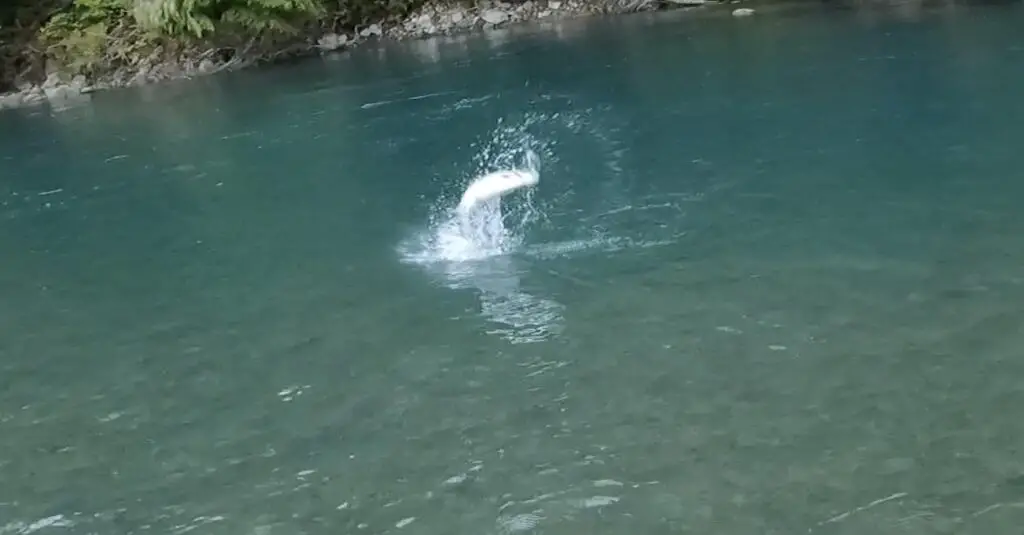
River fishing for salmon is one of the most challenging and rewarding angling pursuits on the planet. There’s nothing like the experience of fishing on a river for a fish of significant size and vitality.
Once salmon are hooked, and often in shallow water, they will explode to the surface or make long line peeling runs that will test your gear and fish fighting skills to the max.
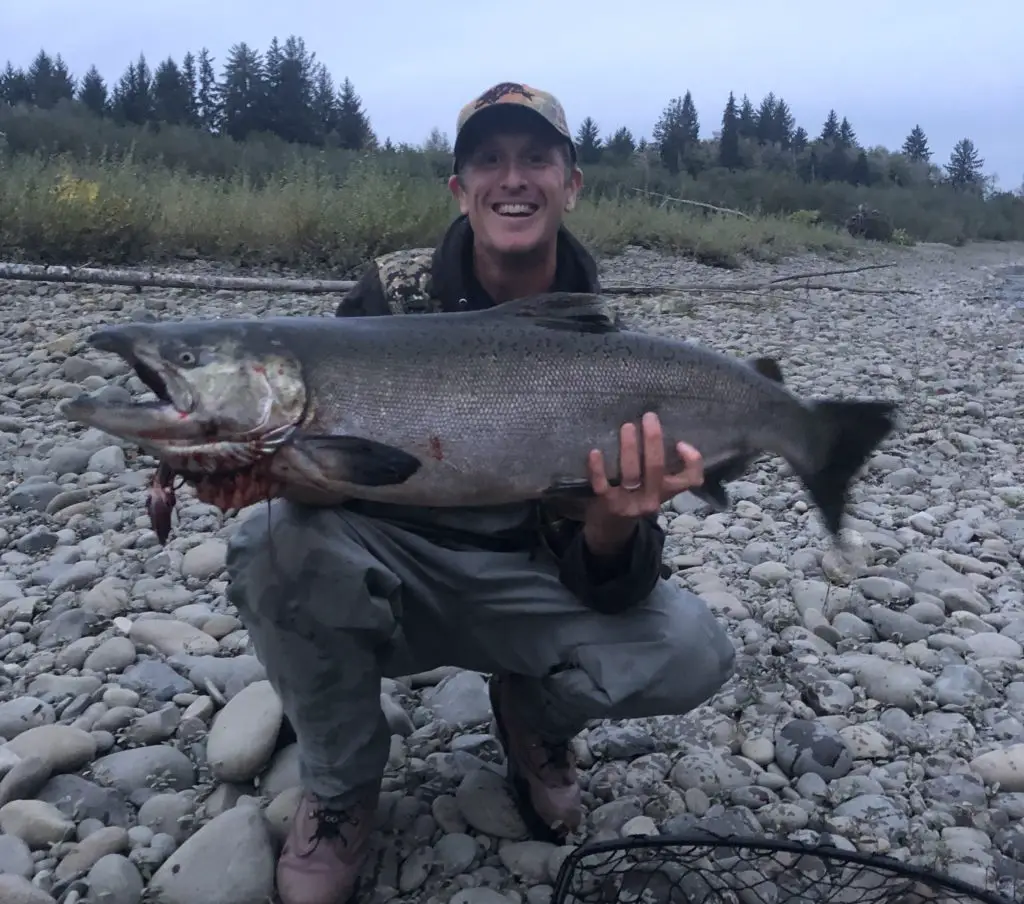
I’ve targeted salmon in rivers all over the Pacific Northwest, but especially in Western Washington, and with this article, I want to share the information you need, in an organized way, to help you have this amazing experience of fishing for salmon in the rivers near you.
This page will constantly expand and grow as an entire book can be written (and several have), on this topic.
Freshwater salmon fishing has a steep learning curve
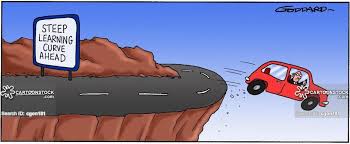
Have you heard the saying that 10% of the anglers catch 90% of the fish? Have you heard of salmon anglers who’ve spent multiple years in pursuit of salmon, but with not a single hookup to show for it?
I will never forget, when I first started the salmon fishing learning journey, I hadn’t had success in my first month of effort, seeing a listing of someone who was selling all of their salmon fishing gear because they were giving it up after several years of effort with nothing to show for it.
The first point I would like you to understand is that: freshwater fishing for salmon is hard. There is a steep learning curve involved, so be patient with yourself and make sure to enjoy just being out in nature, and the magic of being on the river while you chip away at that learning curve.
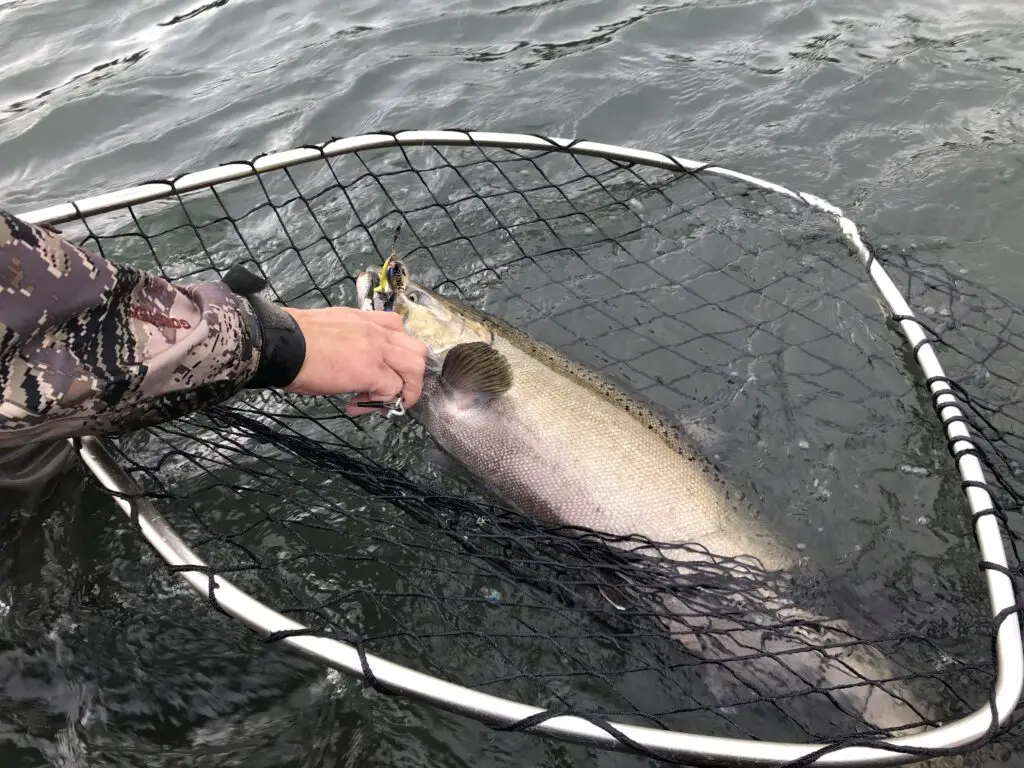
Why do 10% of anglers catch 90% of the fish? Details!
I had a good friend take up the salmon fishing hobby a while back, who had been a fisherman with experience all over the US and he was amazed at how technical salmon fishing in the river can be.
You generally don’t just buy gear, slap on some bait, and throw a line out. There are a few dozen (hundred?) very critical details to be aware of.
Those who ignore those details tend to be in the 90%, and those who have those details dialed in, are in that 10%. This page will cover those details in great…um detail.
Looking to buy a fishing rod for salmon fishing in the river? Checkout my tips on buying your first salmon fishing rod for river fishing.
Do salmon bite in the river?
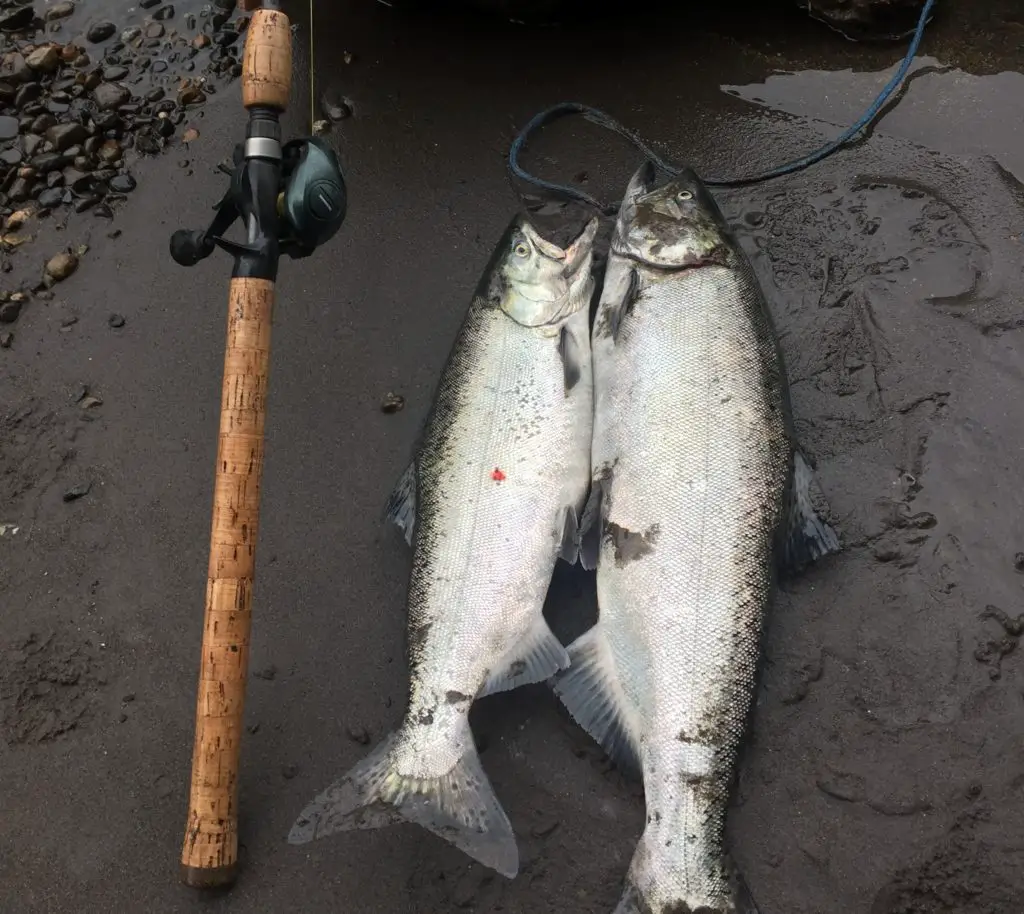
Alright, you cannot got very far in an article like this, without addressing one of the greatest curiosities any beginner will have about fishing for salmon in the rivers. Do salmon actually bite in the river?
Why would anyone ask this question? Some people, finding it very challenging to get salmon to bite their lure or bait, believe that salmon simply won’t bite once in freshwater.
The lifecycle of salmon is such that, as they enter freshwater, their bodies have already started to shut down some of their normal functions like eating.
Their throats close, they stop eating and their bodies start to mature the sexual organs that are needed for spawning at the end of their journey.
This process consumes all of their fat reserves, so the further they go upriver, generally the worse the meat quality will be. Salmon caught lower on the river will tend to be chrome (like the pic at the top) and loaded with fat from recent feeding in saltwater.
So how do you catch a salmon in the river once it has stopped eating? The foundation of almost all angling pursuits is about using a lure or bait that imitates a food source and getting a fish to bite with the intention of consumption.
Not so with salmon.
I live not far from the Puyallup River, which dumps into the Puget Sound near Tacoma, WA. During the summer months, this river essentially has zero visibility due to the fact that it’s primarily fed by the melting glaciers on Mt Rainier.
I started my quest for knowledge of salmon fishing on this river, but I also would purchase and read any book I could on the topic. I read and understood that water clarity often determines leader length in the river when drift fishing (a technique we will cover further down).
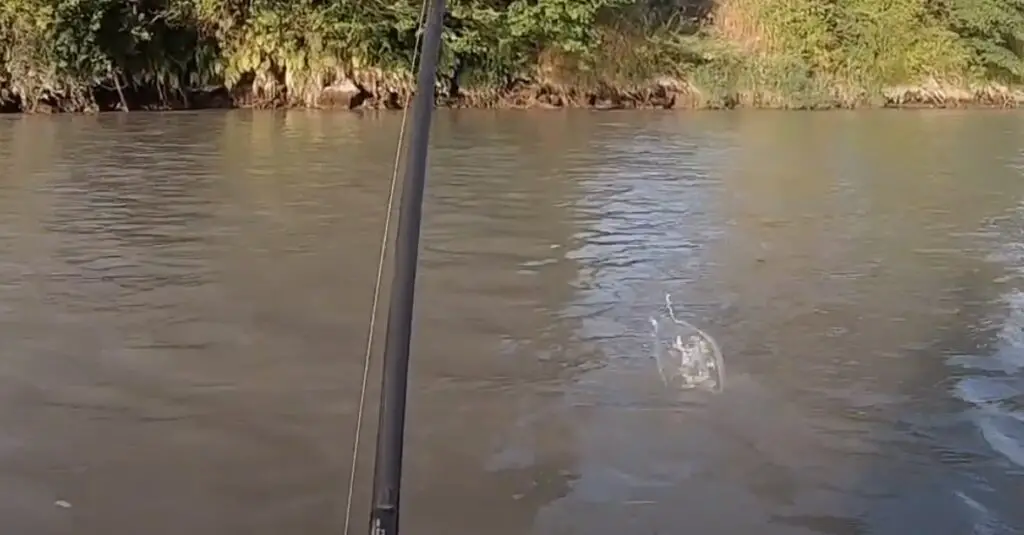
I couldn’t understand why 99% of anglers on the Puyallup, were using 5 ft+ leaders (sometimes 10 ft+ leaders!) when the water clarity was 1 inch, and the “experts” recommended 24″ leader length in those scenarios.
What I learned was that these anglers were using a technique called “flossing”. Check out my page devoted to the topic of flossing for salmon for more information. In learning how to fish for salmon in a river, you have to decide whether to go the flossing route or the “attempting to get the fish to bite” route as the approach and principles are often quite different. This article is devoted to explaining the “getting salmon to bite” approach.
So why do salmon bite in a river if they aren’t eating?
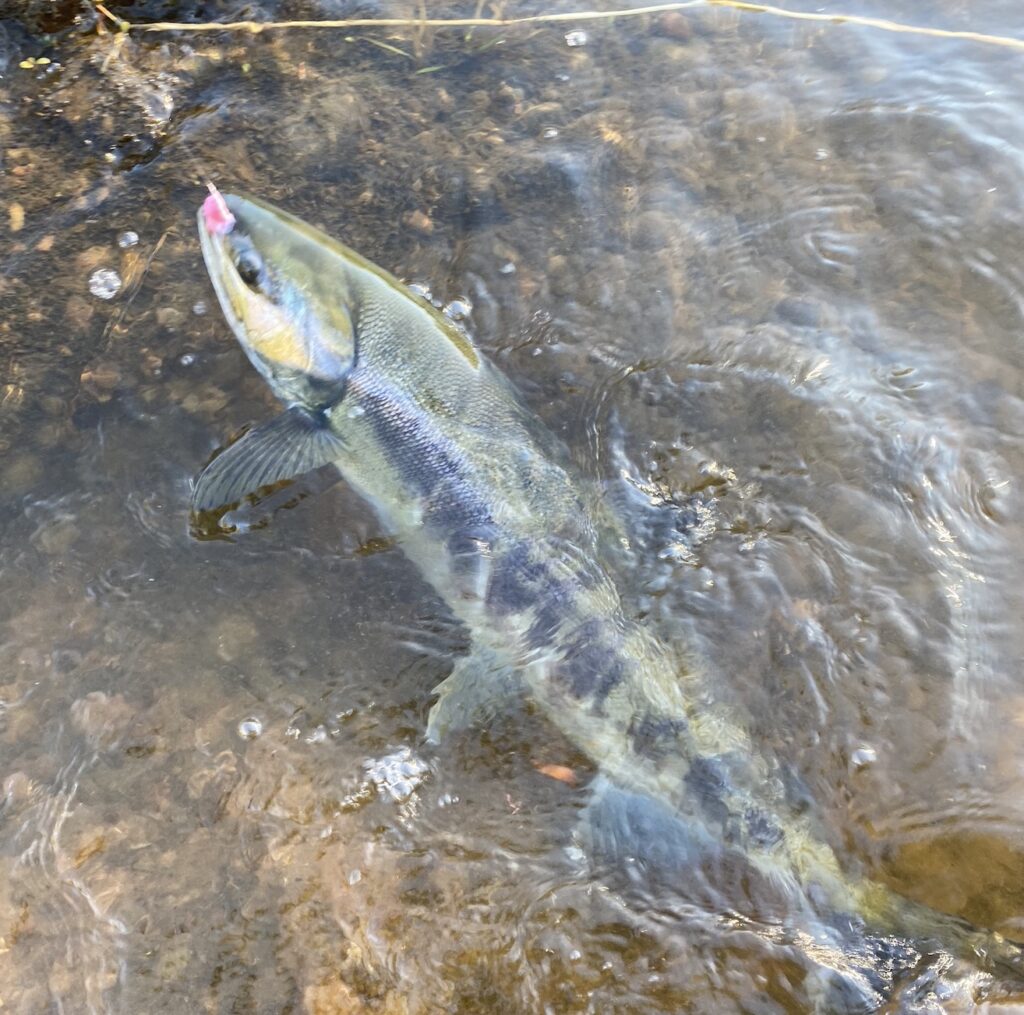
Salmon will bite in the river for largely 2 reasons:
- Sensory stimulation
- Irritation / aggression
Salmon biting due to sensory stimulation
By sensory stimulation, I mean smell, taste, sight, etc. Salmon will bite on presentations that look, smell, or taste like something they used to eat or maybe crave. I don’t think anyone truly knows why a salmon will bite cured salmon eggs, but there are a few theories:
- Salmon eggs may trigger instincts to keep eggs from leaving the spawning area
- May trigger competitive instinct to kill rival eggs
- May trigger based on the taste or smell of something they want to put in their mouths, even if they cannot eat it as many times egg cures are based on krill, shrimp, sulfites, and other goodies.
Corkies and yarn with scents on them basically imitate an egg cluster moving downstream.
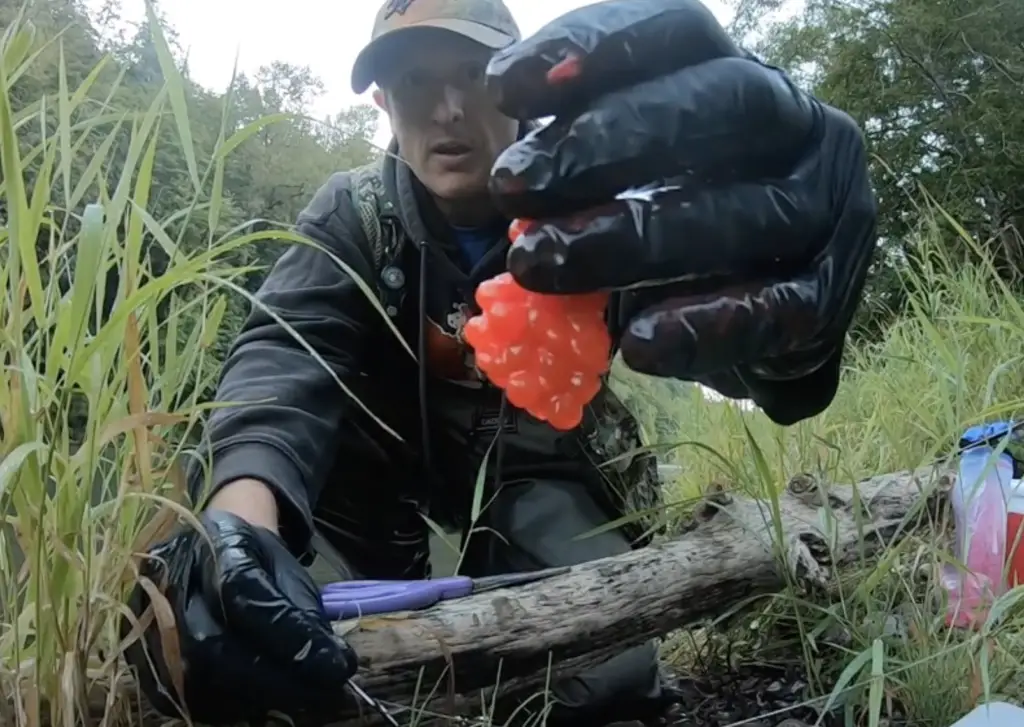
Scent is critical because salmon can smell many many times better than we can. Some say, salmon can smell with the level of detail that we can see. They can smell so good, that they can navigate to their original spawning creek or river based on the fact that each stream has a slightly different smell to it.
Salmon can also be turned off by smells such as human sweat, which is why it’s important to use gloves when handling terminal presentations and while curing salmon eggs
Chinook salmon especially, favor sensory stimulation to get them to bite and are great egg biters.
Salmon biting due to irritation or aggression
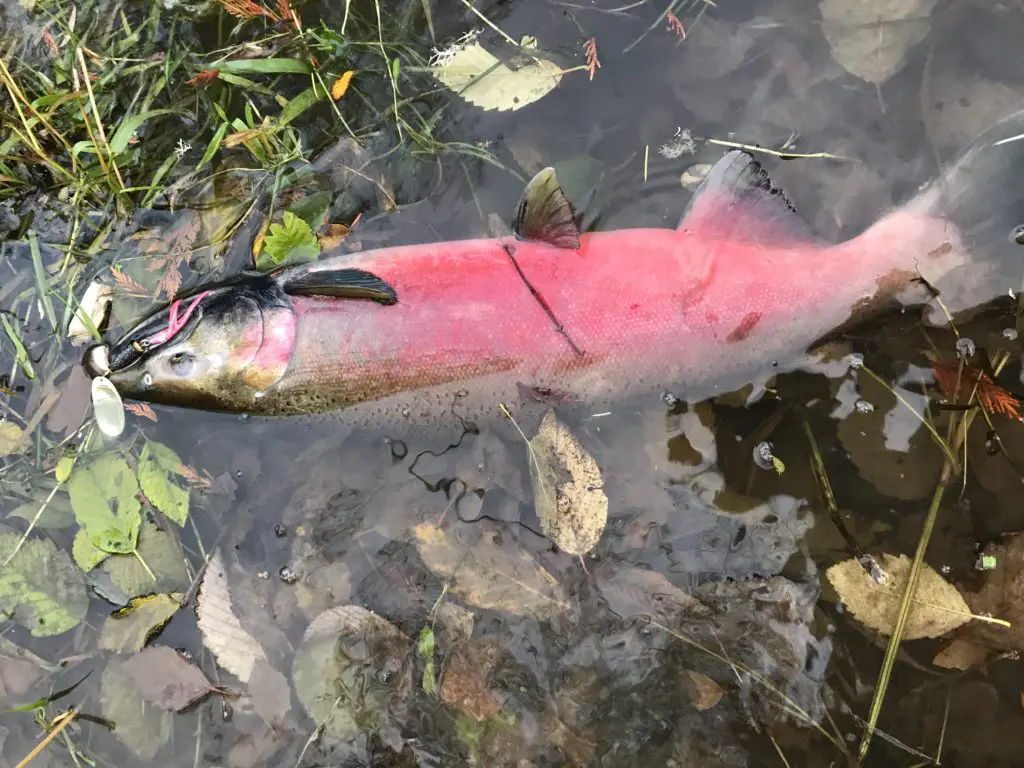
Salmon, like many animals, have a sense of territory and personal space. Species that spend their early life schooled up with many of their kind will be particularly aggressive when it comes to their personal space. This includes coho, chum, and pink salmon, which tend to spend most of their life in large schools and thus when they come into the river are often very susceptible to biting on lures of various kinds.
A properly presented spinner, plug, spoon or twitched jig will often promote violent strikes that will leave you shaking and hooked on river salmon fishing for life. These reactions are often based on sight, so you need a given river to have enough visibility to get these types of bites. Every year, I get the most excited as my glacial rivers clear up timed with the return of ocean coho that I can pursue via fishing spinners and jigs.
My daughter when she was four once asked me if we were being mean by catching and killing salmon. I was caught off guard but tried to think quickly, knowing my answer may determine whether my daughter would continue to fish with me. I replied “Well, we only catch the mean salmon”. She thought about it for a second and quickly responded with: “How do you know if a salmon is mean?”. I replied, “Only the mean ones bite”. She seemed satisfied with this answer, and there’s also a bit of truth to it.
When that spinner, jig, or plug invades their space, salmon strike it, not to eat it, but to kill it. That seems pretty mean to me…just sayin.
Reading water to catch more salmon in the river
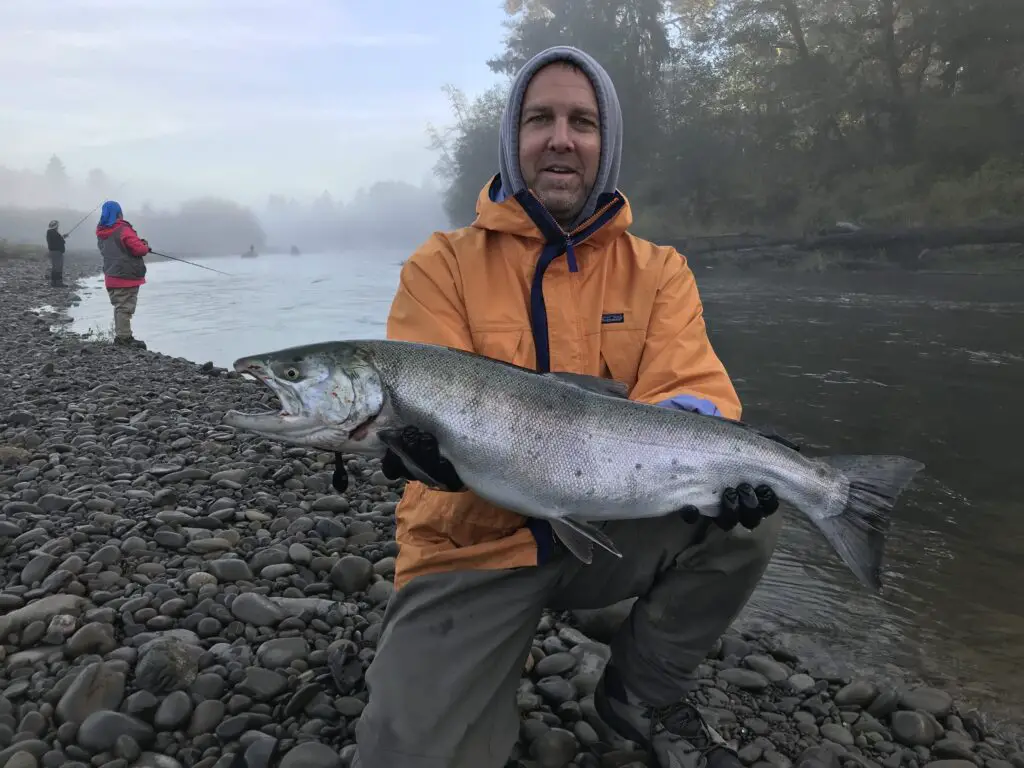
Knowing how to read water in the river is one of the top tips for catching more salmon!
Just like in Real Estate, location is the most important part of salmon fishing in the river. What’s the point of targeting fish that aren’t there? A river is a mountain trail that’s covered in moving water and salmon prefer to navigate that trail in a specific way. A river can really be divided into three types of water:
- Traveling water
- Holding water
- Nothing water
Traveling water is where salmon might be for a short while as they move upstream, it’s fairly self-explanatory, salmon are moving through traveling water. Think of it as a freeway/highway that salmon are cruising through.
Holding water is where salmon will pause and rest on their trek upstream to the spawning grounds. Salmon will spend much more time in holding water than traveling water and in general, are the best places to fish for salmon for the purposes of getting them to bite.
Nothing water is where you will not expect to encounter salmon…like ever.
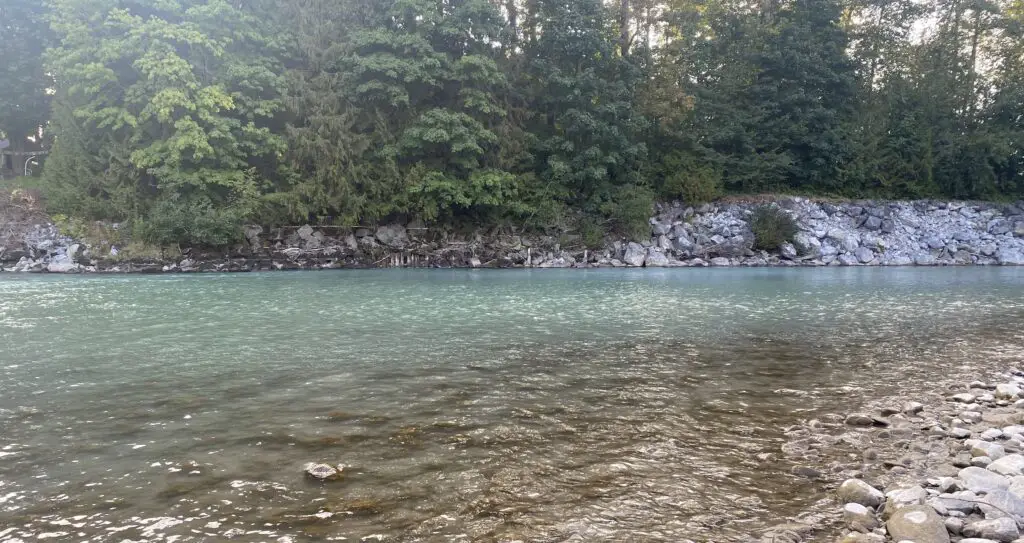
The majority of any river system is traveling water and nothing water. So, one of the first challenges that must be overcome on any river is to locate the small amount of “holding water”. Sounds pretty simple right? Find the holding water, catch salmon, done!
Not so fast…Holding water is different for each species of salmon and it changes as the river flows increase or decrease. Now there are dozens of variables being introduced that affect holding water location. Mix in the fact that if you are bank bound, you are dealing with bank access restrictions and other factors which will even further limit your ability to find this “holding water”.
One of the complaints I often hear from people thinking about fishing for salmon is that they don’t like combat fishing or fishing around a lot of other people. Well, the good news is that since flossing is best performed in traveling water, and since most bank bound salmon anglers are flossing, you will find yourself fishing alone on some great holding water in popular fisheries.
If you can locate and identify it.
How do you identify salmon holding water?
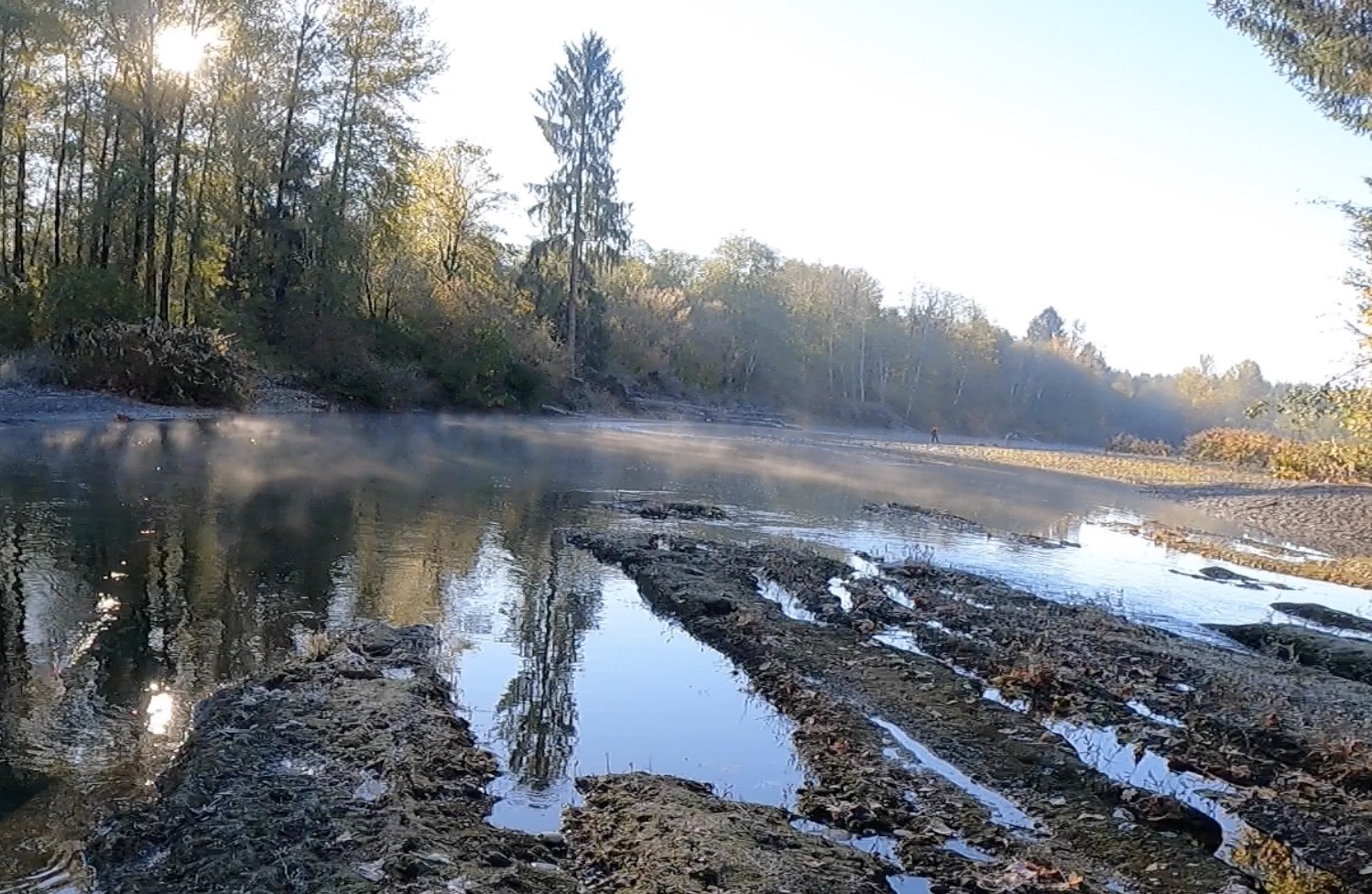
There are a few clues that give this away. Salmon holding water is generally, but not always, deep enough to provide protection, slow enough to provide rest, and will appear after tough stretches of river for a fish to navigate.
Think about it: Where would you stop off the highway to take a rest? Someplace with services, after a long stretch of very little services, someplace safe and inviting.
It’s the same with these salmon. It’s not hard to find slow/deep water that looks like it could be salmon holding water, but salmon will generally stack up and prefer that type of water AFTER a long stretch of hard-to-navigate water such as shallow rapids.
River definition influence on salmon fishing
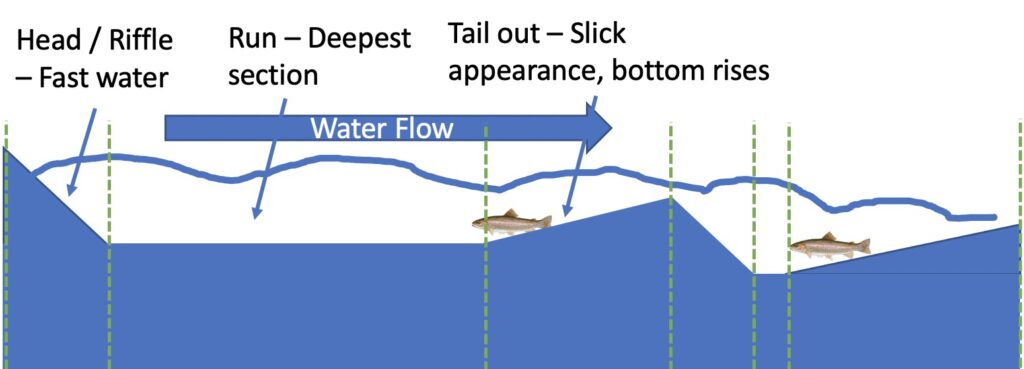
Every river follows a basic pattern of riffle->run->tail-out.
The pattern will look slightly different, but will almost always be followed because of the simple physics of how water moves over ground. Some rivers have more “definition” than others. This means that the pattern of riffle, run, and tail-out will be more obvious.
Generally, the greatest elevation loss is what forms the riffle or rapids part of a section of the river. This water not only will carve bends in the river but will also dig out the section immediately after the elevation loss leading to a scooped-out section of the river. The “run” portion of a river begins at the bottom of that drop in elevation.
The head of the run is usually the fastest flowing water and the deepest. Water is then forced “up” out of the water-created hole and the end of the scooped out area is referred to as the tail out. The tail out is almost always quite a bit more shallow than the run and it immediately transitions to the next elevation loss or rapids/riffle section.
You can almost think of the river as a stretched-out and elongated set of stairs. The riffle is the drop in elevation from one stair to the next, the stair itself is the run, and the lip of the stair is the tail out.
Species specific factors for salmon holding water in the river
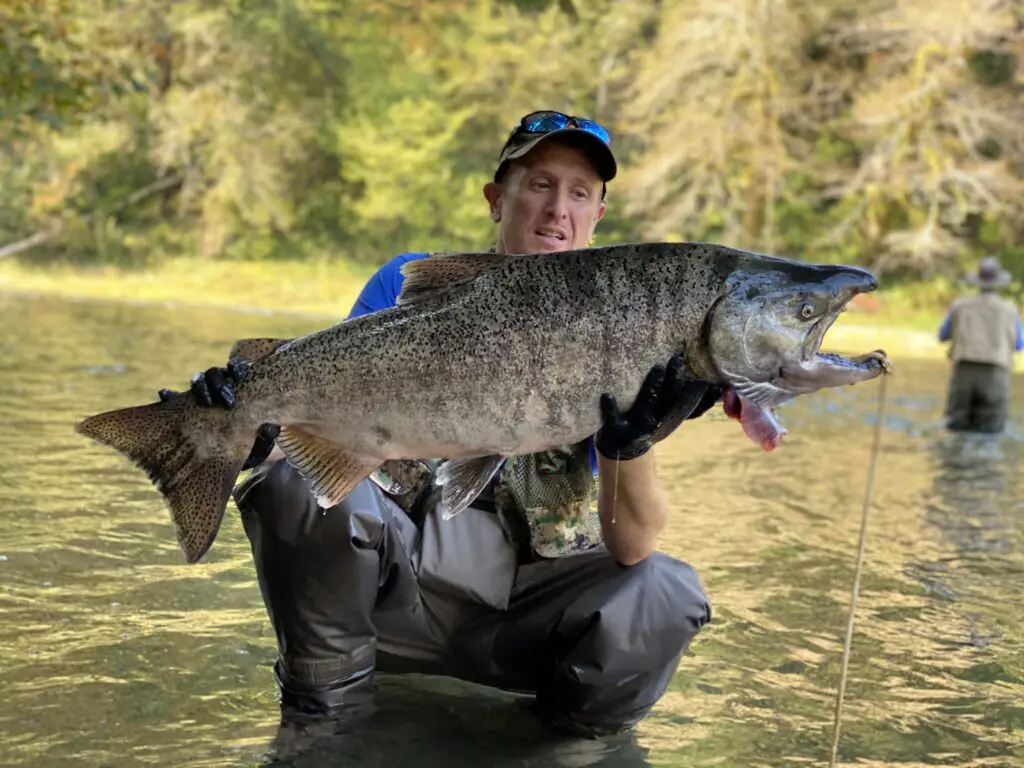
You will almost always find fall king salmon at the head of a run.
Kings are the big bosses of the river, and there is a hierarchy when it comes to holding water.
Additionally, a King can hold in some heavy current with relative ease, whereas a smaller salmon might need much more energy to hold in, and thus they will prefer softer currents.
Coho Salmon you will find in the middle section of a run, sometimes almost towards the tail-out, but not quite.
You might notice salmon rolling and jumping at the tail-out. These salmon, especially in the fall are not biters.
They are salmon in that pre-spawning phase and will simply not voluntarily bite. This is one of the prime locations to floss though, so avoid this section when fishing for biting fish.
Sometimes, the flow of a river takes various sharp turns and carves out deep holes, but later on the river flow changes.
This water is deep, but has very little flow and is referred to as frog water.
Both coho salmon and pink salmon can be found in frog water and are generally very aggressive biters in these areas.
In general, both coho and pinks prefer softer currents, slower water, and soft edges of heavier currents.
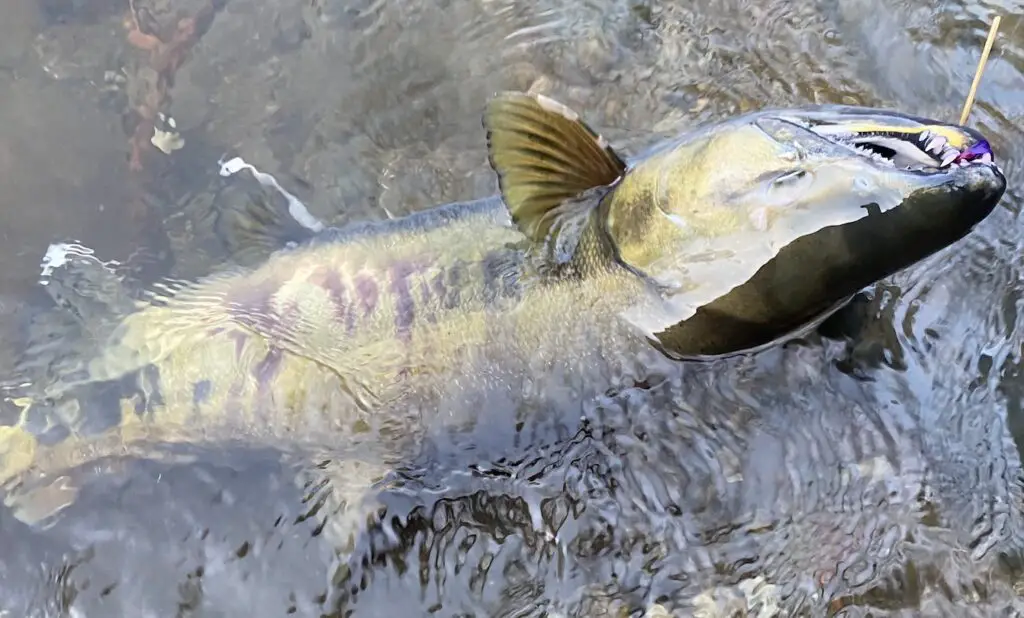
Chum salmon tend to behave like fall kings in many ways, preferring the middle to head of runs.
One of the best places to target fall king salmon is after a difficult stretch of rapids, followed by a run and just before another difficult stretch. These salmon will keg up waiting for river flows to increase or resting up for their next leg.
I was recently fishing in an area like this on a river. When I showed up at dawn, the kings were moving up the shallow riffle into the next section of the river, but as it got lighter they weren’t as bold, and instead just stacked up at the head of the run, with one eventually succumbing to my eggs drifted under a float.
A rare case where the bite got better as sunlight increased.
Salmon that have been holding for a long time tend to not bite nearly as well as fish that are on the move, and may have just arrived at a new holding area.
Timing salmon fishing trips on the river
Just as important as identifying and fishing salmon holding water for salmon is knowing when to go down to the river at all.
Or what about those great rivers 2-3 hours away from your home? When should you go to those rivers and spend the gas money and time, taking a vacation day (or sick day!) off of work to make the trip?
Luckily there are a few great resources and clues that will help you dial this in and be confident about planning a fishing trip to the river for salmon. The above video is a great place to start, but I also cover this information below.
Hatchery escapement reports
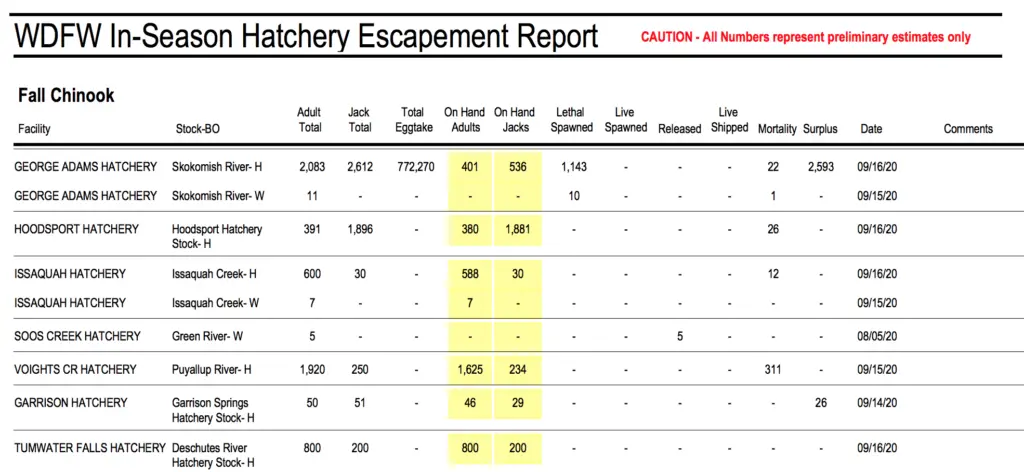
For Washington State, the salmon hatchery escapement numbers are updated each week on Thursdays here.
Make sure you understand which river these hatcheries correspond to and also realize that several rivers/hatcheries are not represented here as well.
For those that are represented, you may want to make sure there is some escapement before you make a trip to the river in question.
You can also subtract from one week vs the last week to see the rate of salmon moving through the river each week. Also, factor in the size of the river.
If 100 salmon have arrived in the last 7 days, that’s less than 15 fish per day moving through.
You may want to hold off until more like 1000 fish in a week or 150 fish per day are moving through for your best shot.
15 salmon per day may be a good number in a small river, but one with much more flow, you would not have a very good chance at hooking a salmon.
I also like to compare salmon escapement to previous years, which are all accessible at the above-posted link.
If the weekly escapement rate is climbing each week and then suddenly declines, you may have encountered the peak of the run.
You can compare the numbers to the previous years to gain confidence in that assessment. Salmon runs which have declining escapement may not be as good to target as runs that have not yet peaked or may be at peak level.
If you look at my river fishing for salmon pages on this website, you will find weekly updated graphs of escapement and historical run-timing graphs to make some of this trip planning work easier.
How river flow levels affect salmon fishing
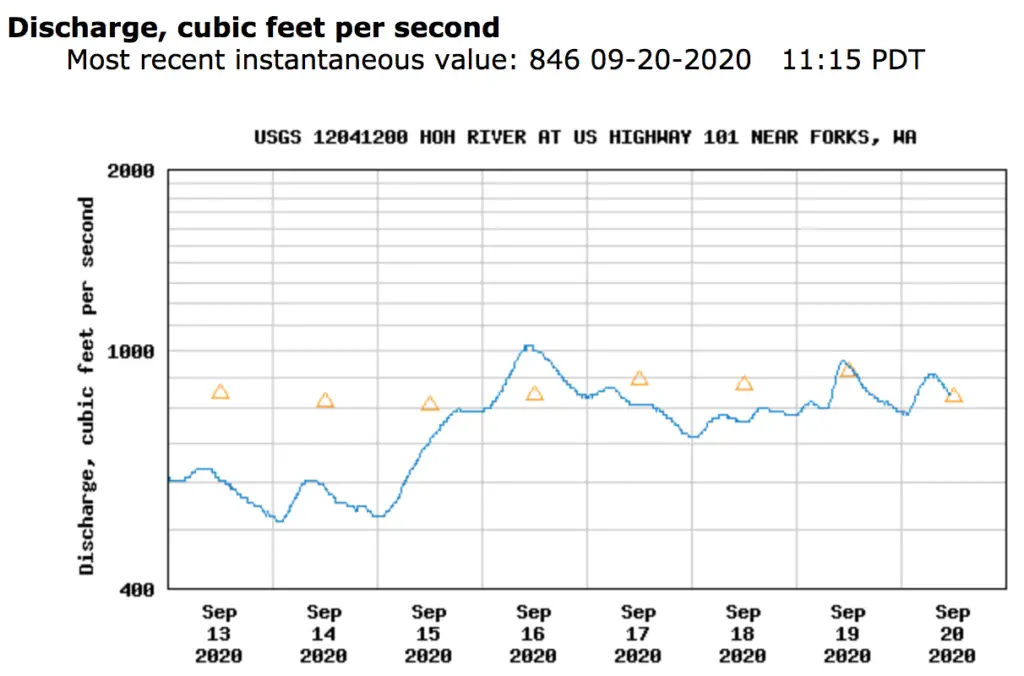
For Washington State, you can use this USGS site which shows the river flows for most major rivers.
One of the most important things you can learn is how a river fishes at different flows. There is not one number that is correct, it is entirely dependent on a specific river.
Obsess over these graphs! Print them out if you need to.
If you have a great day on a particular river, print out the graph and keep it with you so you know what it looks like next year.
I keep a spreadsheet of every fishing trip I’ve been on in the past 10 years and one of the key things I record is the river flow.
I’m not sure any practice or detail has put me on more salmon than this one tip. River flows will allow you to make an educated guess as to the coloration of the river and water clarity, the definition of the river,, and exactly where salmon will hold.
That Riffle->Run->Tail out disappears as river flows increase, and it just turns into one long fast-moving run that will completely change where salmon hold (or if they hold), and more likely it will convert the majority of the river to traveling water. There are methods of fishing to intercept salmon in these conditions, but not what I would call ideal.
Social media
There are a number of Facebook groups or Instagram follows which may indicate vital information about salmon fishing on a given river.
However, bear in mind a few things. Most of the time, information being posted in these groups is fairly stale and sometimes unreliable. Who is going to put the relevant information about where they are getting a hot bite on to social media for all to see?
In the saltwater this is more of a thing because there is a lot of room to fish via boat.
Specific and more obscure rivers putting out salmon? It is very unlikely you are going to see anything recent on social media.
A river like the Puyallup or the Cowlitz putting out fish? Sure. So many people fish those rivers, there are no big secrets to protect. However, don’t expect your favorite coastal river to show up with an accurate report on social media as your sign of “when to go salmon fishing or not”.
What part of the river to fish for salmon based on all the variables?
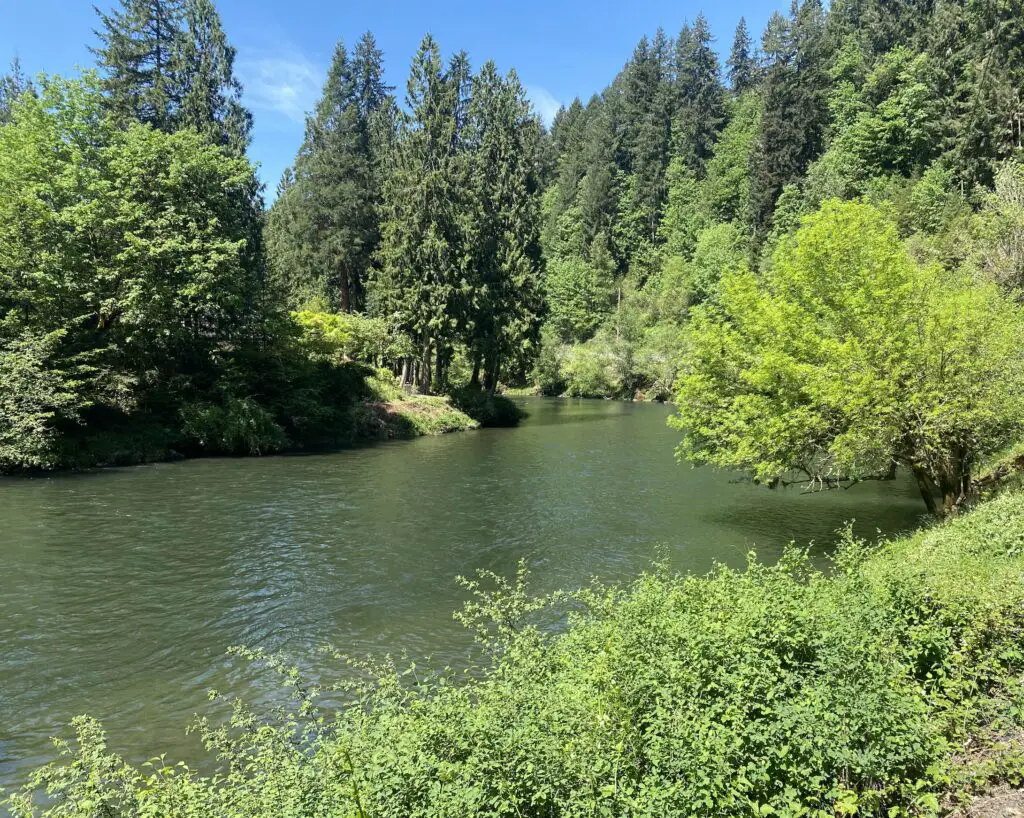
First of all, I recently received this question from a reader, and I realized I didn’t cover this adequately, so thank you Dan!
Understanding this topic is one of the most important factors in increasing your catch rate of salmon. Experienced salmon anglers and guides will labor over this question the most prior to any fishing trip.
There are many factors which influence the answer here, so let’s get started listing them:
- What phase of the run are we in? Early? Mid / Peak? Late?
- What season are we in? Spring? Summer? Fall?
- What is the river’s “navigable (for fish) CFS or flow rate?” and current or predicted CFS?
- Is there a hatchery on the river in question? Have fish returned / escaped to the hatchery yet for the run you are looking to fish?
- Is the river in question tidally influenced? As in dumps into saltwater and river height is influenced by incoming/outgoing tides.
There are likely other factors in question as well, but I think these are the big ones to address.
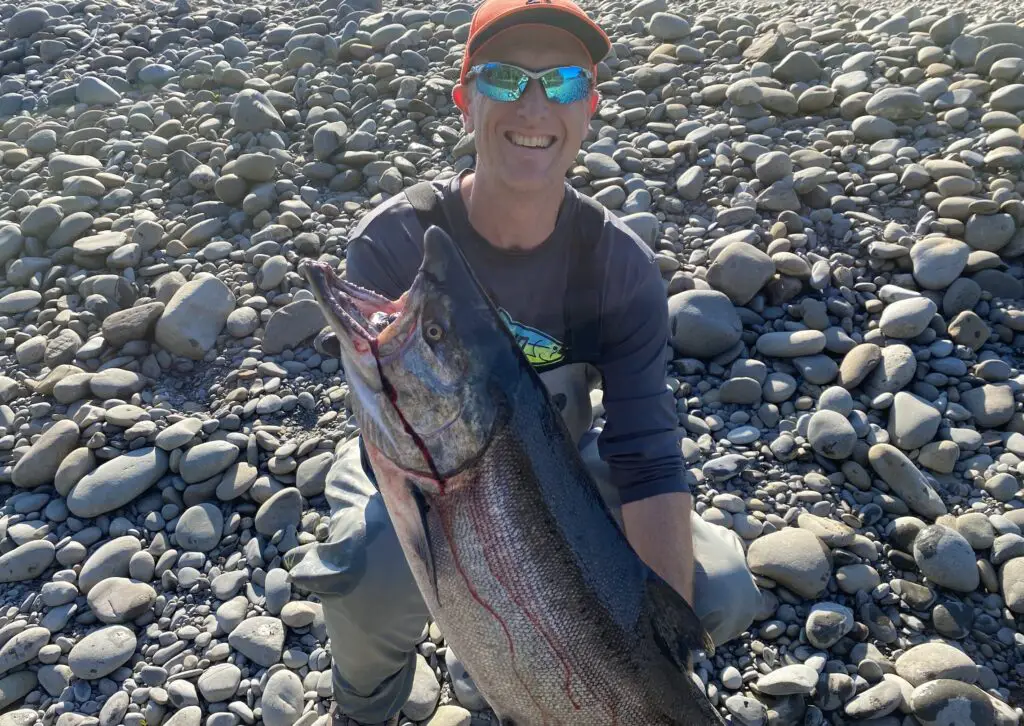
I recently visited a stream I have some solid history with but had to drive a fair distance to access. Knowing what part of a river to fish can easily spell the difference between a great trip catching fish and just a “nice time on the water.”
In this case, I had never fished this particular river as early as I was planning to fish it, but I had a pretty good idea that there would be some salmon there based on my past fishing notes and understanding what part of the river to fish based on the many variables and factors,
As I write this, we are early on in the fall of 2022, and there hasn’t been a lick of rain across a large portion of the PNW. That means most rivers will be at their lowest flow rate all year.
Why is that? River flow primarily comes from two sources: Snow / glacial melt and rain.
So in the early fall with no rain, we have melted a significant amount of mountain snow that will melt, and with shorter days, cooler evenings, and glaciers largely stop melting as well which is why glacial till off-color water rivers will start to clear up even without rain.
Here’s the thing though…salmon have a biological clock that starts ticking independent of these factors…so what do these salmon do when river flows are low? They head into their natal rivers and go as far up as they “practically can.”
While salmon can navigate many difficult river obstacles caused by lower flow, early in a run, they will prefer to stage and wait rather than expend energy to charge upstream.
Early in a salmon run, with low water flow, always start lower down on the river and work your way up until you stop encountering salmon.
This is just one example and it can really depend on factor #3 above regarding navigable flow rate.
Sometimes even during low flows a river will still be navigable for salmon, in which case fish will be significantly spread out through a river system early on in a run. Such as if there’s a dam on the river that releases flows consistently, then it won’t really matter whether we’ve had rain or not.
Often times glacial melt rivers still provide enough flow for salmon as well, not every river drops below navigable flow rates for salmon and you will need to spend time at these rivers in various conditions while taking notes that you can later refer back to (I have a spreadsheet with almost 1000 trips recorded in it).
So let’s walk through these factors one at a time:
What phase of the salmon run on the river are we in?
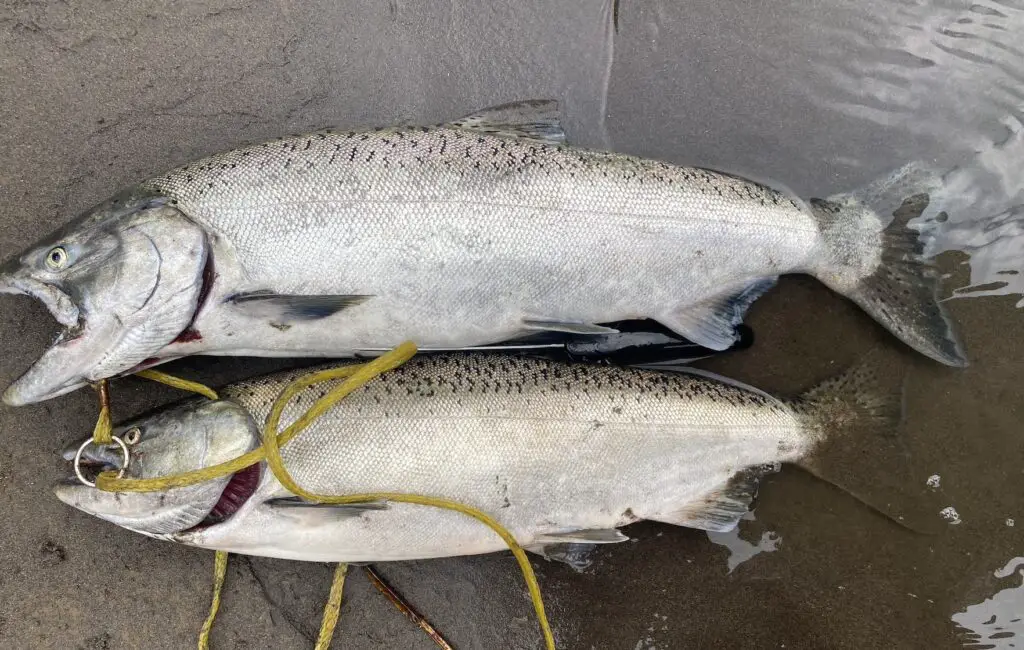
I would characterize this simply as:
Early – The number of salmon entering the river is increasing each week. Fish lower on the river system for the most success.
Mid – The number of salmon entering the river is close to the peak or has recently come down from a peak. Fish the best holding water you have access to on the river based on other factors as salmon will be all through the system.
Late – The number of salmon entering the river is declining each week. Fish higher up on a river system…even if there’s good holding water lower down, salmon will be much more motivated to blow through that water and head to the spawning grounds.
How to tell which phase you are in? Hatchery escapement data is often a really good source. If there’s no hatchery on a particular river, you may just need to visit the river to do your own research.
Social media posts will almost never reveal the early phase of a run. By the time a river is blowing up on social media, it’s usually in the mid or late phase of a run.
Note: The early phase typically provides the best fishing and the highest table-fare quality salmon. The fishing is often good simply because you aren’t competing with as many anglers even with fewer salmon around.
What season are we in for the salmon run?
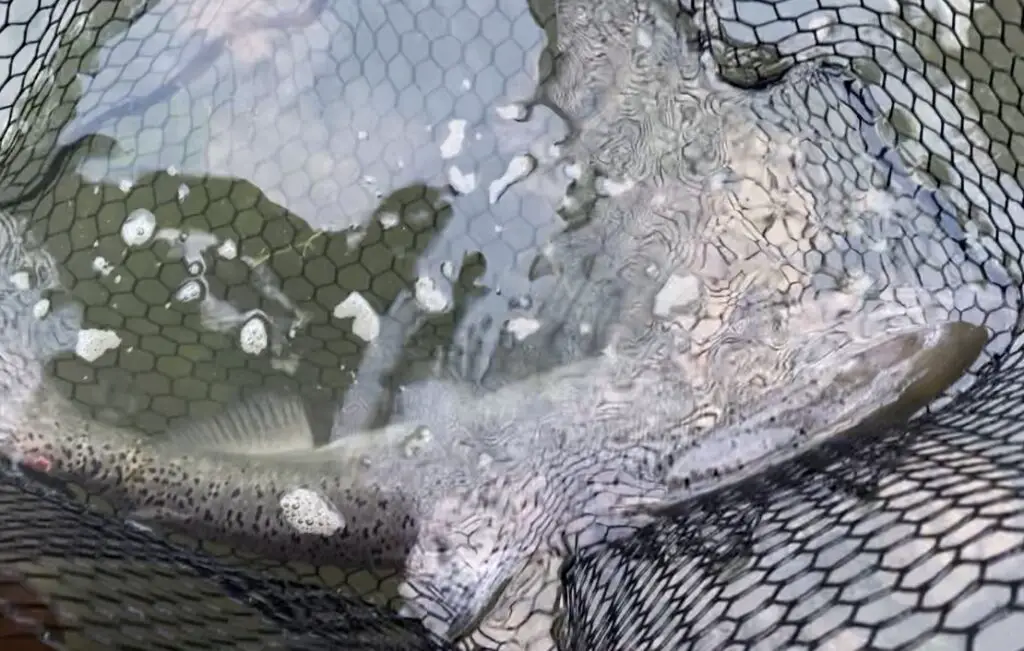
Spring – Springtime flows are usually not at all an issue for salmon due to snow melt combined with lots of rain. Note: This may mean you need to target a run closer to mid-peak simply as a result of too much water relative to how many salmon will be in the river during the early phase.
The rule here is often to follow the water. After a large surge of rain and increased river flows, you target higher up the river system. The longer it has been since the last surge, you target lower on the river system.
Summer – Usually there’s less rain, but flows are still good due to lots of snow / glacial melt being available. However, flows are often more predictable, so you can generally follow a run through each phase. Early – fish lower. Late – fish higher on the river.
Early fall – Always focus lower on the river in the early phase of a run in these conditions unless there’s a dam on the river releasing steady flow, then treat it more like summer conditions.
Late fall/winter – In this season, you will have both very high flows and potentially very low flows, so following the water is extremely critical to finding lots of salmon wherever you decide to fish.
What is the rivers “navigable (for fish) cfs or flow rate?” and current or predicted cfs?
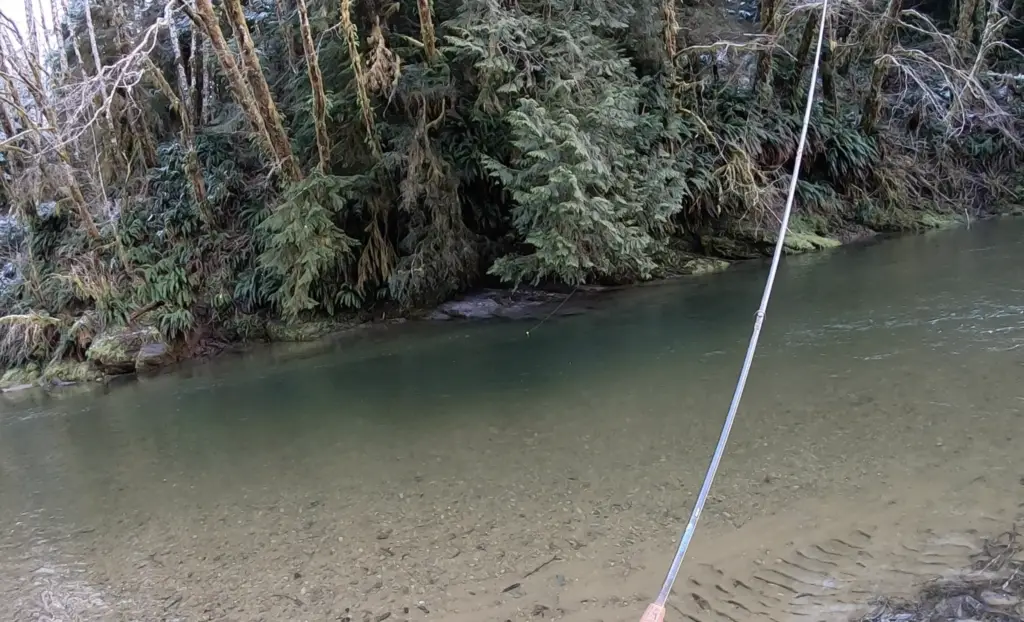
The lower the flows get on the river, the more definition develops and accentuates the pattern of riffle, pool, and tail-out.
The higher the flows are, the more it will resemble one large long fast-moving run that won’t be very fun to fish methods outside of plunking a few feet from the bank.
Some rivers will get so low that tail-outs only have a few inches of water. Salmon can still swim up these areas, but they won’t be motivated to do that early in a run.
Fish the best holding water downstream of the first very difficult-to-navigate stretch of water for the best results.
Is there a salmon hatchery on the river in question?
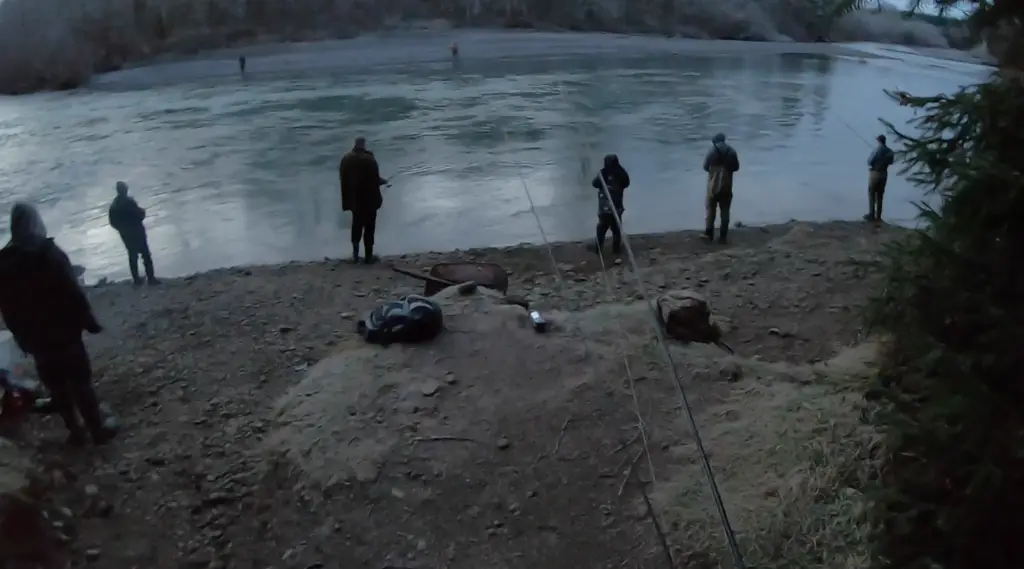
If you are targeting a hatchery run of salmon, as is often the case, using the hatchery to help you figure out where to fish can eliminate many other factors. There are a few things you should consider here:
- Always fish downstream of a hatchery (Where it’s legal to fish! Often the water immediately below a hatchery intake is closed). It’s true some hatchery fish will go upstream some distance before turning around, your best salmon fishing is typically as close to a hatchery intake as is legal to fish.
- If there is no escapement at a hatchery, consider a few scenarios: A – No salmon have returned yet and it’s too early to fish the river. B – Salmon have returned, but the hatchery has not reported it yet to WDFW (some hatcheries will sit on this for weeks!). C – No salmon have returned, but in a long river system where the hatchery is many miles from the entrance, salmon may still be in the river, just very low on the system.
- If there is escapement at a hatchery, in many cases expect there to be 2-6 weeks before the run peaks (sometimes longer), and you can expect salmon to be spread throughout the river system.
Is the river we want to fish for salmon tidally influenced?
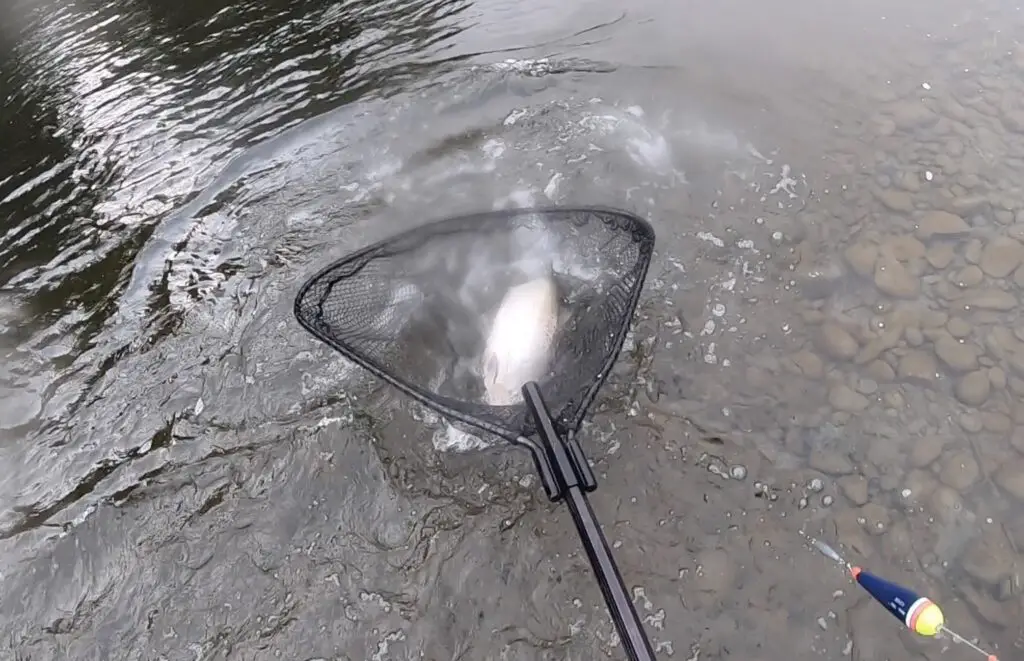
In a tidally influenced river, it’s vitally important to fish the early phase of a run based on the tides.
Salmon will often spend significant time in the tidally influenced lower part of a river system before continuing their journey upriver. I believe they will spend much less time later on in a run, but early on the time spent can be considerable and provide epic fishing.
If you know anything about the famous Buoy 10 fishery on the Columbia River, you immediately get what I’m talking about here.
Salmon will swim upriver with an incoming tide and let the outgoing tide take them back downriver again before eventually committing to charge upriver to complete their journey.
Fishing higher up in the lower tidal stretch of a river on the later part of an incoming tide makes sense and also focusing mid->lower in the tidal areas on the mid to later part of an outgoing tide. However, when an outgoing tide switches to incoming, you want to be even lower to catch those salmon just entering the river.
Realize too, that the beginning of an outgoing tide will trigger some fish to commit to head upriver vs swimming back down. So if you are fishing good holding water just above the tidal area, expect fresh salmon to enter the holding water on that tidal change.
The best techniques and rigs for salmon fishing in a river
There are many techniques for catching salmon in a river, and I aim to cover them all at some point. I will however start with the most popular and applicable to the most rivers and situations:
Drift fishing for salmon
This is by far the most common technique for salmon fishing in the river. It’s also the preferred technique for flossing. There are some specific details to incorporate, to target biting fish with drift fishing and to minimize flossing.
Drift fishing for salmon involves a weight, a leader, and the terminal rig made up of a hook with some sort of flotation like a drift bobber, cheater or corkie.
The cast is made across the river into a target salmon holding or traveling water, usually, but not always upstream of the fisherman. The current of the river will cause the weight and terminal rig to drift downstream to hopefully a waiting salmon. At the end of the drift, the rig is retrieved and the process repeats itself.
Take a look at our drift fishing for salmon guide for much more details on this popular technique.
Float fishing for salmon
When you’ve arrived at the point that you are float fishing for salmon, you are now seriously engaged in the sport of salmon angling. Float fishing makes a ton of sense as a targeting technique over drift fishing for a few reasons:
- You are always targeting a bite, there’s no question of flossing fish
- Prime holding water is usually slow enough for a float-based presentation to be successful
- You are not on the bottom, so you aren’t getting hung up or having to retie nearly as often as drift fishing
Drift fishing still has a few advantages in certain conditions, but most serious salmon anglers leverage the float angling technique. Float fishing always involves a float, some weight below the float, and a leader to a terminal offering, which is usually a hook with bait, jig, bead or some combination.
You can read much more about the details involved with float fishing for salmon here.
Spinner fishing for salmon
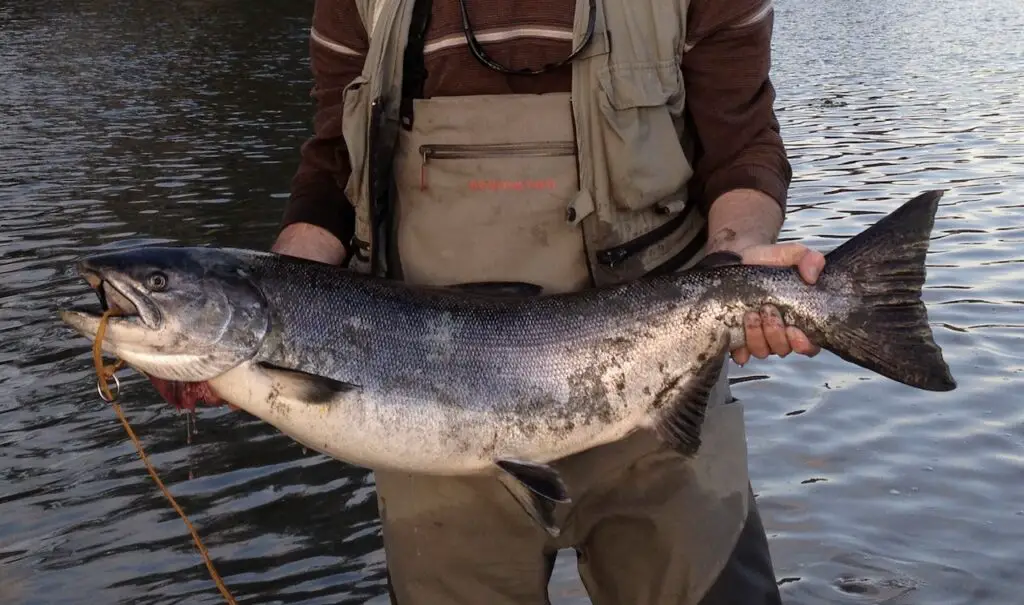
When you’ve experienced the heart pounding moment an angry salmon attempts to obliterate a spinner you are slowly working through the prime holding water of a river, you will truly understand the saying “the tug is the drug”.
Look, fishing for salmon with spinners is often not the best way to get some species of salmon to go, but you will be hard-pressed to find a more exciting way to fish for salmon in a river.
There are two primary spinner fishing techniques I wrote about in my detailed guide.
- Heavy body spinners working across and downstream
- Light body spinners working from upstream down.
Detailed guide to spinner fishing for salmon.
Each technique requires paying close attention to your rod and line angle while working through a drift. The goal in every spinner fishing technique is to work a spinner as slowly as possible while the blade continues to spin and work the bottom 1/3rd of the water column.
Twitching jigs for salmon
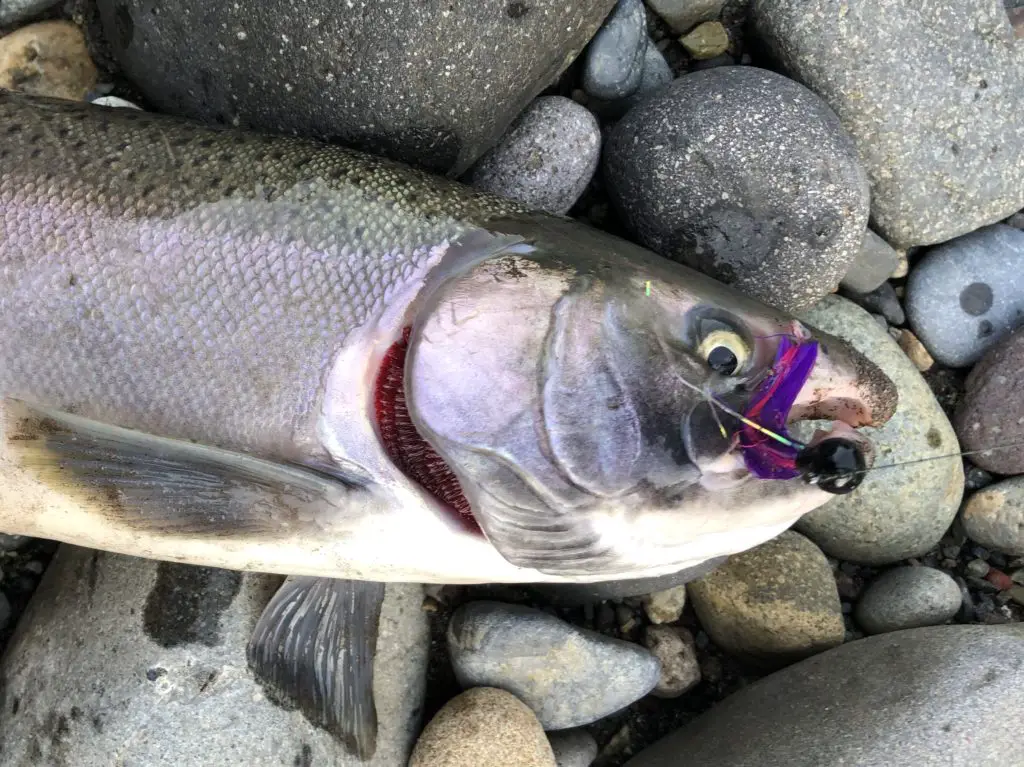
While the spinner fishing bite may be the most exciting to feel, the twitching jig bite may be the most satisfying. That feeling of a fish on, first felt on the upswing of the jigging action always brings me a smile.
Twitching jigs is one of the most fun techniques to use to catch salmon in the river and it’s how I caught my first ever river salmon.
If like me, you grew up bass fishing, the jig-twitching technique may even be something you are familiar with. If you’ve never done it before, you absolutely have to give it a try. I’ve caught nearly all species of salmon with this. King, coho, chum,, and pinks will all succumb to a properly twitched jig.
There are basically two jig twitching techniques based on the type of water they are appropriate for, which I will go into much more detail on in my soon-to-be-written detailed guide to twitching jigs for salmon.
- Twitching jigs in slow moving deep water
- Swimming jigs in faster moving holding water / drifts
Each technique requires choosing the right size of jig and even more importantly, giving it the correct action by rapidly raising and lowering the rod tip.
Here’s a recent video on twitching jigs for salmon:
Gear you should consider for salmon fishing a river
There’s a tremendous amount of tackle to consider buying to help you catch salmon on the rivers, and I’m not aiming to cover all of the possibilities. Some of the technique-specific guides have more information in them.
I do want to cover some of the things that will help you have comfortable and successful fishing trips.
Waders for river fishing
Let’s start with waders…
My approach to buying waders after years of fishing hard in a pair of waders all season long is to go to Sportco in Fife and buy the cheapest pair of breathable waders they offer.
Waders are either stocking foot, or boot attached. If you plan to fish only a few times a year, it may be better to just buy the boot attached waders. There are positives and negatives to both.
Boot foot waders will be cheaper, but are not going to be as comfortable. Additionally, while the stocking foot waders will cost more, partly because you have to buy a pair of wading boots to go with it, they tend to not last long.
Most of my waders have eventually sprung a leak right near the seams on the stocking feet. When that happens, just toss them. Don’t try to repair them, don’t set them aside for your friend to eventually borrow them and get mad when their boots fill with water…not that I’ve ever…uh..done that before…
So why not just buy a really expensive pair that won’t leak? I’ve done that, and yeah they still eventually leaked. Perhaps I’m just a serial wader abuser…That’s why I go cheap and just buy new ones every few years as part of my river fishing for salmon habit.
Waders will come in two material types: Neoprene and breathable. If you ONLY plan to fish in the winter/late fall/early springtime and you get cold easily you may want to go the neoprene route. For everyone else, go breathable. That’s what I do. I can always layer underneath the breathable waders. I can also handle summer and early fall situations much better.
If you are hiking distances in waders, and you have neoprene, you will be a sweaty mess by the time you reach your fishing spot. Hiking in boot foot waders is also not generally a good idea due to comfort issues.
Lastly on waders for river fishing…I like to use these neoprene booties to protect my foot seams longer on my stocking foot waders. If I can spend 20$ and get another year or two without needing to buy new waders, it’s a big deal!
Backpack for river fishing for salmon
In your quest to become a good river fisherman for salmon, you will end up needing something to store all your tackle and other goodies in. Don’t mess around with the old traditional tackle box!
Here’s the thing: A good chunk of your river fishing for salmon will involve wet conditions, as in rain. It’s tough to avoid it when fishing prime time (fall) in the Pacific Northwest or wherever it is often raining while you are out fishing.
A traditional tackle box combined with lots of tackle sitting in the little slots and just a dash of water equals a giant rusty stinky mess that will ruin a future fishing trip.
You need a backpack that you can hike to the fishing spot and back, that is also waterproof.
Go bigger rather than smaller as well. I keep my tackle in water proof containers and store them in a water proof bag and my tackle stays dry until it’s being used.
You arent kidding about that learning curve…its taken me 3 years to learn to fish my home River.
This page is amazing, wish I had stumbled upon it years ago.
Wanda, thank you for this positive feedback! Helping people have more success is what keeps me energized! My next page on spinner fishing for salmon will be dropping soon.
Oh man im definitely in the 90% stage but im still getting out there and trying!!! Also thanks for the little blurb at the end of the OP rivers report lol I legit was thinking damnn now I’ve missed my chance
but im still getting out there and trying!!! Also thanks for the little blurb at the end of the OP rivers report lol I legit was thinking damnn now I’ve missed my chance
Thanks for commenting Jessica! I just got back from the OP, follow me at kyle.towle on instagram to see how we did. The OP is one fire right now.
What part of the tide is best for salmon (particularly coho) for fishing the lower end of a river that’s most effected by the tide?
This is a great question…the early part of a run of salmon such as coho (but they all basically behave the same), will prefer to start moving in as the tide changes from ebb to flood. Call it like 1 hour after low tide, you will start to get pushes of fish moving up river. This will continue until high tide. As the tide starts to ebb, fish pushing into the river will really slow down unless it’s a later part of the run when the fish are more urgent.
You should use 1 river mile per hour to estimate the movement of fish upriver. So if you fishing 5 miles from the salt, you may want to start fishing right around HT for the best results.
There are many other variables that can change the above ideal scenario, so what I’ve done in each river system is kept very good notes over the years. I can now look at a tide chart and know the best time to fish a particular part of many river systems.
I’m a huge fan of your blog and videos ! Thank you very much for tutorials, Since this is my 3rd year salmon fishing so very appreciated .
I live in east Washington . This year I’d like to extend my fishing trip to Olympic peninsula or near to fish king since local rivers are getting very crowded.
Any pointers ? Which river is easiest access ? Etc ? Thank you
Sorry for the late reply, was on a trip fishing. All rivers are pretty crowded these days…and the ones that aren’t I cannot name drop on a public blog like this…
Where in Eastern WA do you live? I’m not as familiar with salmon opportunities there, but I know they are numerous. On the west side, it’s all about fishing water away from the crowds. Away from hatchery terminal areas and using techniques other than flossing which requires different type of water. Most people floss on rivers, so you can get away from crowds on most rivers by fishing slower holding water.
Hope this helps, connect with me on IG or facebook messenger to chat more in depth.
Kyle
Last year was my first try at salmon in rivers. I’m from Kansas and came to visit my don who lived by Bonney Lake.
A couple questions.
Bank fishing in your terminology involves using waders. I gave never owned waders .
Any recommendations on a wader purchase – I see there are two types – frog togs and “normal” waders.
The second question is about your gloves. In videos you often have gloves on. Us it fir warmth or scent? What type do you recommend?
Stuart,
Thanks for taking the time to comment! Waders are definitly a great idea…some people try to get by without them, but those are the most crowded bank fishing spots. If you can get into the water and often times that means wading in cold glacial melt rivers (like the Puyallup), you’ve gotta go with waders.
Frog togs are just a brand of waders…there are really two types of material: 1. Breathable 2. Neoprene. Breathable waders are typically what I recommend because I can wear them in the winter just with lots of layers on and I tend to want to hike around, which is brutal in neoprene.
Another two categories of waders is stocking foot vs boot foot. Stocking foot are more comfortable, but you have to buy wading boots, and if you use them a lot, the seams will wear out on you. I end up buying a cheap pair of breathable waders every other year. Don’t even bother with patching them.
I wear black thicker nitrile gloves. Mostly because I don’t want my scent to get on my offering and because a lot of the bait I handle can really stain your hands. Also, in the salt water, your hands will get quite dried out without gloves.
For warmth I go with the fingerless buffalo gold gloves. These are a must if your hands lose circulation in cold temps. They can be spendy, but man do they make a difference.
Kyle,
Thanks for the help. I’m heading to Bonney lake today. Purchased some inexpensive breathable waders and Simms boots (with the additional cleats). Will try fishing on the Puyallup river later this week (I noted the closures (Sunday- Tuesday ). Will pick up some gloves when in the area.
Will watch closely where people enter the river – as based on your information there is no clarity in the water.
Thanks again.
Awesome! Good luck. I’m seeing some salmon being pulled out of there lately.
This is a great article and I picked up a couple of good pointers here. One thing not mentioned that I find is the biggest issue for me – where on the river to target at what time. Not specific types of water, just how far up or down a river is best in different situations. This to me is key to regularly catching fish, especially when you have good experience with all the other factors and know how to spot good water. Would love to see a follow up article concentrating on this subject.
Ooh, that’s great feedback, I will add that section! I’ve been thinking about this a ton and it’s something I’ve got pretty well nailed and can share.
Kyle, this additional section is fantastic. Thanks so much for adding it! Essential info right there, very helpful.
Excellent, thanks Dan!
Best thing I have read since I started up fishing again. I am so happy to have this resource. So insightful.
I feel so grateful to have found this website Kyle, and I also appreciate the comments of your readers.
I moved to Lynden, WA from Cincinnati this summer. We live very close to the Nooksak River in Lynden. I’m brand new to salmon fishing, and only moderately experienced with bass fishing back in the midwest.
I fished the river today for the first time and couldn’t help but laugh at how unprepared – if not fully lost – I felt. After my legs finished freezing in the knee deep water, I decided I should do more research on fishing this river in my area before I start buying waders. I wear a size 15 boot and am 6’5″ so my options are limited and thereby considerably more expensive.
I suppose I have a few questions:
1. Can you give your general feedback about the Nooksack? Many folk around here speak disparagingly of it in regards to Salmon fishing.
Pro: There is a hatchery some 10 miles or so down river from me, so I would assume fish are coming through.
Con: The river seems to run quick to me. The long tern median flow is 1,490 this week. Is that number agreeable for shore fishing?
I am unsure if the river is as poor as folks say it is, especially when they compare it to what it was like some 35 years ago, vs the likelihood that these people do not possess sufficient technical knowledge needed to succeed on this river. I’m sure there are other options too.
I will continue to do research, but any tips or resources would be a huge help.
My gear setup is woefully not set up right.
I thought before I moved here that there would be a much higher success rate with a fly rod, but it seems that fly fishing is better suited further east.
I’m going to go to Dave’s Sport Shop in Lynden and begin investigating how to get my rod and real set up appropriately.
For float fishing, do you have a “Kyle’s Build Your Tackle Box – what I would buy to get started” list?? If not, I would find that very helpful.
What is your general feedback on purchasing gear vs purchasing from my local tackle shop? I prefer to support local businesses focused on our sport; however, I also consider it important to be price conscious.
Do you have a video on hatchery charts?
I would find it VERY helpful if you did something like a screen share and talked us through the data you seek out, how you interpret & apply it, and any other tips or thoughts. The same would be cool for the river’s flow rate.
In a final comment, I in complete alignment with your general zeal and love for this part of the country. My kids and I have a ritual of saying, “I can’t believe we get to live here”. Your work is making it even better.
Thank you for your time and thoroughness.
Mark,
You’ve given me some excellent stuff to work on to expand here!
I don’t know a ton about the Nooksack river, but my impression of it is that it’s a great place to target salmon due to it’s relative size, hatchery and access. You will always encounter negative people who talk about the way things used to be, but often times they’re just trying to discourage newcomers because they would like to be the only person on the water.
Fly fishing is for trout and for those who are bored with catching salmon the conventional (easier) way. It’s not something I cover in salmon fishing as this site is about harvest recreation and fly fishing is counter productive to that.
Most people you encounter on the river will be drift fishing (read as flossing), but you will want to get setup for float fishing and with spinners for the best experience. I’ve written considerably about all 4 methods as sub-pages to river-fishing-for-salmon, so I would start there. I’ve also made quite a few videos on it.
I will definitely add based on your feedback here as well. Also, take a look here for some info I’ve put together regarding the Nooksack, and especially graphs that auto-update with escapement data: https://pnwbestlife.com/nooksack-river-salmon-fishing-2022/
Thanks for reading and commenting!
-Kyle
Thanks, great pointers, I have only been salt fishing and did very well this year with Coho, went up to the skagit scouting last weekend, will give it a try today, saw 2 guys in a john boat and an eagle, plus one large King jump and 3 silvers moving over some shallow water. Will have to pick though my gear and see what I have, do have lots of lures.
Definitely checkout the https://pnwbestlife.com/river-fishing-for-salmon/spinner-fishing-for-salmon/ article and also maybe checkout the Cascade river up there. Good luck!
Thanks, Kyle!
Great post and later additions.
I’m a fly fisher and found a lot of your insights very helpful.
And you finally explained the what and why of hardware fishers I see.
Keep up the great work!
Dean,
Thanks for the comment and feedback! What was the “what and why of hardware fishers” explanation you liked?
Thanks!
The flossing vs floating. I see fishers doing both and didn’t understand the difference.
Ah got it!
Also, and you may already be aware, but often times salmon fly fisherman like to floss too!
Could you tell me about your set up for salmon fishing on the Puyallup?
Leader length , test lb ? (Mono or braid?) , corky size and weight you’re typically using?
Did awful last year and was hoping you could provide some info on what you’re running
Have you read my article on Puyallup River Salmon Fishing 2022? I cover all of that there I believe…Those trying to cut their teeth on salmon fishing in the Puyallup river will encounter many challenges due to the low visibility. Taking your salmon fishing knowledge from other places with good visibility will deeply conflict with what people do on the Puyallup.
I also wrote an article about “flossing for salmon” as a child page to this one that’s worth a visit because that’s what most people on the Puyallup are doing during the summer season when the glaciers on Mt Rainier are melting.
Generally though, I’m using a 30-40″ leader, 20 lb flouro leader, braid mainline. size 12 corkie sometimes x2. 1/2 oz slinky weight.
I’ve been fishin the Nisqually for several years.
A couple of yr.s didn’t even get a bite.
First year I was gettin frustrated so tried “flossin” fer a couple wks w/no success so switched back to drift fishing and managed a couple of pinks and lost one king.
Got SKUNKED the next year.
Managed a long distance release of a nice silver the next year fishing eggs below a float.
Got SKUNKED the year after (2022)
To make a long story short – could you recommend a guide who could school me in (successful) Nisqually bank fishing.
I’m a senior and a veteran on a fixed income so can’t really afford to make more than a scant few trips to other rivers, due to gas/maintenance costs.
Figure I might be able to save up for one guided trip a year.
Problem is i cant seem to locate a Nisqually guide for bank fishing (all the guides fish from boats and don’t seem to be experts on bank fishin and are reluctant to guide a bank fishin trip.
Can’t really afford to fish Riverbend Campground either. I usually fish from the schoolhouse to the Campground.
In lieu of a guide, any Nisqually specific tips or tricks will be greatly appreciated–I could send some excellent smoked salmon to show my appreciation…
Feel free to contact me by email if you’d like
Take care n stay safe
Tight lines Roger
Email sent!
Come fish the Olympic Peninsula with us.
Sure! When we going
How, where would you target fall chinook in the Columbia River, from a kayak? Water can be up to 80 feet deep, and very slow.
Kyle,
Thanks so much for your many articles. Short sob story; been fishing the Nisqually river for several years and skunked every single outing. I came across your site and read your articles. Unfortunately, it must be the section of river I am fishing from but I can’t seem to catch anything but trout with bobber/eggs or lures (of any kind).
Read your drift fishing article and decided to try that. Most fishing the banks are using a 10ft+ leader (sigh…), no corky and only a simple hard bead or two. I know what they are doing, and so do they.
This is the first year that I have actually caught something (Pink salmon). Used 2x #12 corkys most of the time and my hookup/landing rate went up vs 1x #10 (both with #2 hook).
Having read and re-read your articles, I noticed you use a lot of braided line (30lb braid, 20lb leader).
I have been using 12-15lb for a leader and so far I have not had any issues. For whatever reason, braided line and I just do not get along at all. It all ends rather badly in real short order, brand doesn’t seem to help or make a difference either.
I have a 150 size and a couple of 200 size Shimano baitcast reels, and 4000/5000 spinning reels. Do you have any recommendations for using monofilament as a main line?
Many thanks!
I used to use mono for my mainline and it can work just fine. There are a few reasons to use braid, but primarily it’s about smaller line diameter relative to breaking strength. Also, with float fishing, braid will float far better than mono, which is really helpful for mending your line and keeping it upstream of your float.
The section of river you fish really matters. The right sections to fish with float and/or lures are often a bit different than the places people floss, though that’s not always the case as there’s plenty of flossers who don’t know that the best flossing water has faster currents.
The nisqually can be tough because access to the river. The best available holding water not choked with people is at the campground, but you will pay for it. Literally.
Kyle,
You are absolutely right about the location as that is where I have been fishing this year. I was fishing down stream in the public fishing area the last several years and it’s a sad sight when “50lb braid is no good” and they start using 80lb… Ludicrous speed hooks sets to boot that result in broken hooks and snagged gear. I thought he was going to break his rod too when he snagged again…
I do agree that braid has a much smaller diameter relative to it’s breaking strength. That is what drew me to it years ago. I went the other direction, mostly kept the same or slightly higher breaking strength and increasing the capacity. I look at the manufacturers recommendation on the braid diameter and try not to go too small of a diameter. But as previously mentioned, I tend to run into problems with braid more often than not where I do not have such issues with the mono.
For mono, what would you recommend for lb-test main line? I would like to keep an open mind and keep my options open on the braid as well. As expensive as some of the japanese braids are (varivas) are they any better than the more commonly available brands?
Thanks again.
Just curious, but what are the problems you run into with braid? I generally want to run braid so I can run a stronger leader, because I don’t want to break off on other people’s gear sitting in the river. That requires at least 15-20 lb test leader. If you run that leader size, you have to run larger mainline by quite a bit or you risk breaking your mainline instead of the leader which might leave a lot of line in the river and be a big pain to re-tie, especially if you have like a float rig, which is what I fish a lot. So take all of that, and…do really want to run a 20-30 lb mono mainline? The reel you would need to use for that would be quite large…
Kyle,
I usually run into problems where the braid and leader in conjunction with the weight, tangles in flight or even once everything splashes down and it comes back in a big ball. I end up loosing anywhere from a couple of yards to more than 10yds, plus the time to retie everything. Sometimes its every cast and sometimes things go smoothly for a while. I have a few days here and there where I don’t have any issues at all.
Other times I end up wind knots wrapped around the tip and then some, and have to cut and retie. Could be a few feet to several yards.
You are right about the diameter of 20 and 30lb mono, its rather large compared to the same in braid. I agree that heavier lines and leaders help when you get caught on someone else’s line that they left in the water.
Here is how I have things setup; main line with a barrel/snap swivel (sliding 3/8oz to 5/8oz weight), a bead, and mainline tied to a barrel swivel. From there I have my leader (with a corky or 2) tied to the hook.
Could the issues I am having with braid be a result of how I have things setup?
Potentially…I mean, I’m generally out on drift fishing in most scenarios just because I don’t like the re-tying business combined with flossing BS. I find float fishing and lures a much funner and more satisfying and often more effective way to target salmon.